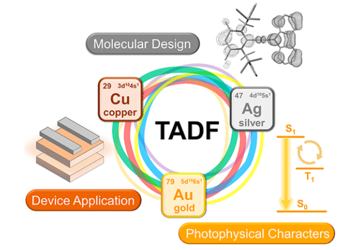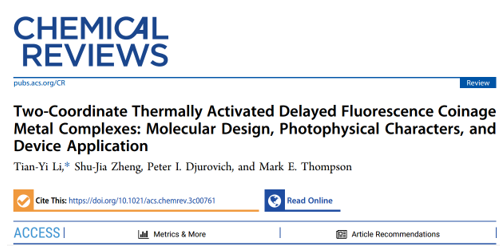A review by Prof. Li Tian-Yi on electroluminescent materials from Chem. Rev.
Since the appearance of the first organic light-emitting diode (OLED) emitting green light in the mid-1980s, OLED displays have flourished globally. Noble metal phosphorescent complexes such as Ir, Pt, Os, Re, and Ru have attracted attention due to their ability to achieve 100% electroluminescence internal quantum efficiency. Currently, commercial OLED emitters all use phosphorescent iridium complexes. However, due to the low reserves and high material costs of such noble metals, people are constantly searching for cost-effective electroluminescent materials. Pure organic TADF molecules have lower costs compared to noble metal phosphorescent complexes, but the presence of long-lived delayed fluorescence leads to serious efficiency roll-off issues in OLED devices. Therefore, new TADF emitters with short emission lifetimes and reasonable costs are of great significance for the sustainable development of the OLED industry.

In recent years, Prof. Li Tian-Yi from our department has conducted distinctive research around a novel class of coinage metal (copper, silver, gold) bimetallic TADF complexes, summarizing the relationship between molecular structure and photophysical properties. The research includes: Pioneering investigations on the excited-state Renner-Teller distortion effect and the non-radiative energy loss mechanism it particularly induces. This research proposed molecular design strategies to suppress non-radiative energy loss and enhance luminescence efficiency (J. Am. Chem. Soc., 2020, 142, 6158). Designing a dual-core concatenated carbene structure to increase luminescence efficiency by extending the electronic cloud delocalization range and reducing the energy gap of singlet-triplet state, thus accelerating radiative transition rates (Chem. Eur. J., 2021, 27, 6191). Revealing the modulation mechanism of various photophysical properties by the degree of overlap between the emission and ground-state electron clouds. This study summarized molecular design principles for enhancing luminescence efficiency and shortening luminescence lifetime (J. Mater. Chem. C, 2022, 10, 4674). Developing a series of TADF copper complexes with indole ligands and controlling luminescence color through chemical modification, resulting in efficient blue light materials and the fabrication of blue OLED devices (Angew. Chem. Int. Ed., 2023, 62, e202217195).

Recently, Prof. Li Tianyi was invited to write a review paper titled "Two-Coordinate Thermally Activated Delayed Fluorescence Coinage Metal Complexes: Molecular Design, Photophysical Characters, and Device Application" in Chemical Reviews, a top-tier journal in the field of chemistry published by the American Chemical Society. This paper comprehensively reviews the development history, structural features, synthesis methods, and factors influencing the luminescent properties of two-coordinate coinage metal TADF complexes. It systematically summarizes the methods for determining key photophysical parameters and the advantages of quantum chemistry in studying emission mechanisms. The paper classifies cMa TADF complexes into categories such as CAAC, MAC/DAC, imidazole carbene, and other types of carbenes. It provides a detailed analysis of the photophysical properties of cMa TADF complexes and summarizes their main applications in devices. Finally, it elaborates from multiple perspectives and in-depth on the advantages, disadvantages, optimization directions, and key challenges of such TADF materials, providing important references for the further development of two-coordinate coinage metal TADF materials in OLEDs and other fields.

